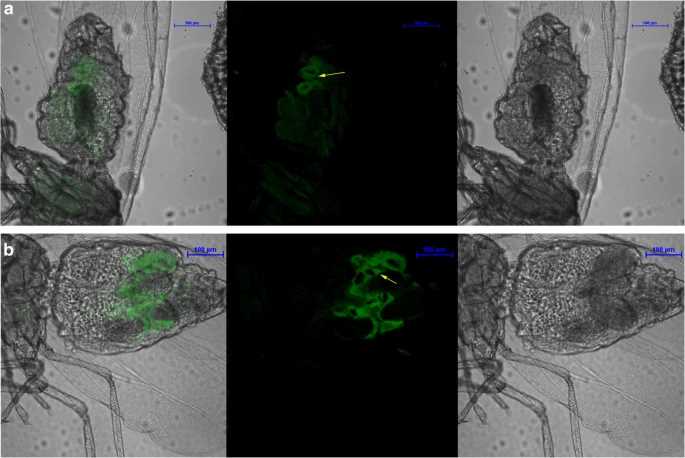Arbovirus Expression Analysis in Insects
Creative Bioarray provides visual analytics solutions for localization and expression analysis of viruses in insect hosts and plant tissues during arbovirus infection and transmission. Through different types of customized synthetic probes, customers can achieve personalized analysis needs. Our platform has sophisticated synthetic probe customization capabilities, and we are able to provide corresponding protein-level resolution (with optional IHC analysis). Help arbovirus infection researchers in agriculture-related fields gain more knowledge through our FISH technology platform. Diversified choices and high-quality service teams make us a powerful helper for your research.
Insect Hosts in Arbovirus Infection
Detection of unculturable bacteria and their localization in the host by fluorescence in situ hybridization (FISH) is a powerful technique for studying host-bacteria interactions. Methods of localizing cellular components such as nucleic acids, proteins, cellular vesicles, and microorganisms including viruses, bacteria, and fungi have become an essential part of any research program in the biological sciences that visualizes these components. The rapid development of microscopy tools and techniques and the associated fluorescent labels and fluorophores of many cellular components has rapidly advanced the application of this FISH to a viral transmission. And of course, the design of molecular probes based on DNA and RNA sequences and the ability to visualize antibodies by fluorescence. The research on the route and infection site of some common arboviruses in insect vectors, plant and animal tissues is of great significance for agricultural production. The transmission of arboviruses between these insect hosts can be achieved by visual analysis of viral expression, and FISH combined with microscopy methods can help to discover different modes of transmission and their pathways in pamper virus infection. These methods are very important in the study of some insects and viruses closely related to agricultural production. Our technology platform provides a visual analytics solution for the host analysis of arboviruses associated with agricultural production.
 Fig 1. FISH staining of 16 S rRNA in Bemisia tabaci. (Priya N G, et al. 2012)
Fig 1. FISH staining of 16 S rRNA in Bemisia tabaci. (Priya N G, et al. 2012)
Expression Localization of Arboviruses in Insects
Analysis protocols visualized using FISH can address the localization of viral expression in studies of various arthropod-borne viruses (arboviruses) that cause animal and plant diseases. Our FISH service platform provides visual analytics solutions for the infection of these insects and related plant viruses. These protocols can help the research to analyze the transmission route of the virus in the host, host localization, etc. At the same time, our technology platform also provides customized solutions for different types of synthetic probes, which can help researchers to customize personalized analysis solutions. In plants, FISH markers help localize viruses in different tissues. Of course, some viruses are transmitted in a cyclic manner with food intake between individuals of different hosts, and this type of transmission is persistent. Once the insect vector has acquired the virus and the virus has completed a specific transmission route, this transmission will continue for the remainder of the insect's life. The phloem and xylem insect intermediate hosts (some sap-sucking insects) in plants are the most important insect groups for the transmission of agriculturally important plant viruses. Our FISH analysis service can help researchers locate viral expression in the gut of insect hosts to elucidate the relevant vector transmission routes.
 Fig 2. FISH assay for expression analysis of insect arboviruses.
Fig 2. FISH assay for expression analysis of insect arboviruses.
If you are interested in our service, please contact us for cooperation. We look forward to cooperating with you in the near future.
References
- Priya N G, Pandey N, Rajagopal R. LNA probes substantially improve the detection of bacterial endosymbionts in whole mount of insects by fluorescent in-situhybridization[J]. BMC microbiology, 2012, 12(1): 1-9.
- Kliot A, Ghanim M. Fluorescent in situ hybridization for the localization of viruses, bacteria and other microorganisms in insect and plant tissues[J]. Methods, 2016, 98: 74-81.
All products and services on this website are only suitable for non-medical purposes.


 Fig 1. FISH staining of 16 S rRNA in Bemisia tabaci. (Priya N G, et al. 2012)
Fig 1. FISH staining of 16 S rRNA in Bemisia tabaci. (Priya N G, et al. 2012) Fig 2. FISH assay for expression analysis of insect arboviruses.
Fig 2. FISH assay for expression analysis of insect arboviruses.


